| Pages:
1
2
3
..
13 |
jdowning
Oud Junkie
    
Posts: 3485
Registered: 8-2-2006
Location: Ontario, Canada
Member Is Offline
Mood: No Mood
|
|
Silk Oud Strings - Making Sense of the Historical Data
Once completed, it is planned to fit the oud - subject of the topic "Old Oud - New Project" on this forum - with 'historically correct' silk strings.
For those who have been following this project, there has already been some preliminary thought and discussion presented. This thread will take the
investigation further and in greater detail.
As historical silk oud strings are not commercially available today, the aim of this thread is to explore how such strings may be made so that,
hopefully, others will eventually be able to make their own strings.
As a prelude, it is essential to recognise and pay tribute to the very important pioneering work of Alexander Rakov in researching and making silk
instrument strings. I am not sure if Alex is still involved in string making activities (although he probably is) but, for those interested, a
detailed account of his experiments can be found on John Thompson's web site about the Chinese zither (guqin) - an ancient instrument that also was,
originally, fitted with silk strings.
http://www.silkqin.com
and
http://www.silkqin.com/03qobj/strings/raykovstrings.htm#update
|
|
|
FLIPAX
Oud Junkie
    
Posts: 311
Registered: 10-13-2009
Location: Dubai, U.A.E
Member Is Offline
Mood: Bayyati Shuri.....
|
|
H!
Awesome Thread! 
I wonder How Silk strings feel to your fingers.
Is This Only Handmade or can be Bought in a Store?
Thanks
Philip
Every time I Hear The Oud, I fall into a Deep Long Trance of Perpetual Bliss!
"Naseem Al Rooh"
|
|
|
jdowning
Oud Junkie
    
Posts: 3485
Registered: 8-2-2006
Location: Ontario, Canada
Member Is Offline
Mood: No Mood
|
|
The feel of silk strings under the finger or risha (or bow) all depends upon how the strings are made. Alexander Rakov's description of his
experiences with silk string making gives some indication of this.
Silk strings for the oud are not - to my knowledge - commercially available so will have to be hand made by any oudist willing to try. Alexander
Rakov's objective is to encourage players to do just that - make their own - hence he makes freely available his methods.
This thread has the same general objective but will be limited in scope to trying to make oud strings strictly in accordance with the data in the 14th
C. Persian manuscript "Kanz al-Tuhaf" as given by Dr G.H. Farmer's translation.
Whether or not this will result in 'successful' silk strings being made remains to be seen.
|
|
|
jdowning
Oud Junkie
    
Posts: 3485
Registered: 8-2-2006
Location: Ontario, Canada
Member Is Offline
Mood: No Mood
|
|
There is no question that oud strings - according to the earliest records dating from the 9th to 14th C - were made either from silk or gut (sheep's
intestines).
(As the European lute was a development of the oud it would seem likely that lutes were also strung with the same materials. There are some who would
deny that silk strings were ever used on lutes but that is another story not relevant this discussion!).
In order to better understand the possibilities (and difficulties) in trying to replicate historical oud strings from silk, it will be necessary to
start from the beginning.
Silk filament is produced by a variety of moth caterpillars to spin their cocoons - although only a few are of commercial interest. The species of
moth of primary interest for string making is the Bombyx mori - domesticated by the Chinese exclusively for silk textile production many thousands of
years ago.
The silkworm (caterpillar) produces the cocoon filament from two spinnerets in its head. The cocoon raw silk filament or Bave is composed of two
strands (Brin) of protein (Fibroin) cemented together with a natural gum (Sericin).
Sericin and Fibroin are of about the same Specific Gravity, Sericin accounts for about 25 - 30% of the total weight of a raw silk cocoon filament.
Sericin is soluble in hot water, Fibroin is not.
Silk fibroin is elastic and proportionally stronger than steel.
The cross section of the Bombyx mori Brin is approximately an equilateral triangular and that of the Bave, approximately elliptical - however, there
are dimensional and geometrical variations - silk being an organic material.
The attached images show an idealised, model Brin section - measuring, typically (for modern silk filament), 10 microns (0.01 mm) in 'diameter' - and
an associated model of the Bave measuring about 25 microns (0.025 mm) in 'diameter'.
The area in red colour represents the Sericin gum.
A micron is a millionth of a metre so we are dealing with microscopic dimensions finer than a human hair.
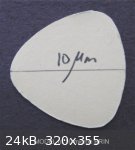
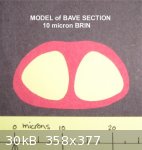
|
|
|
jdowning
Oud Junkie
    
Posts: 3485
Registered: 8-2-2006
Location: Ontario, Canada
Member Is Offline
Mood: No Mood
|
|
Raw silk filament is variable in dimension and geometry - dependent on a number of factors such as silkworm species and strain, feeding conditions,
environmental factors etc. Furthermore, a cocoon filament varies in 'diameter' throughout its length - increasing in size for roughly the first 50% of
the cocoon and then diminishing thereafter. Perhaps, for this reason, silk filament destined for the textile industries is sold by weight - as it
always has been throughout history.
The industrial standard measurement is the Denier which is the weight in grams of 9,000 metres of cocoon filament or thread (multiple filaments) but
this is not very useful when trying to figure out the size of threads in an historical silk instrument string where cross sectional area is of
interest.
Some modern researchers have established a typical 'diameter' of a Bave to be about 23 microns with the Brin averaging about 10 microns (with a mean
'diameter' between 9.3 microns to 11.5 microns).
Measurements were made using an optical microscope - a 'diameter' being the maximum width of Bave or Brin - neither of which is circular in cross
section.
The raw silk filament samples in these tests likely came from a strain of Bombyx mori moth bred to produce filament best suited for modern high speed
reeling machines - so may not be typical of silk filament produced by other historical strains of moth (now extinct).
However, as a starting point for this investigation, a Brin mean 'diameter' of
10 microns will be assumed.
|
|
|
jdowning
Oud Junkie
    
Posts: 3485
Registered: 8-2-2006
Location: Ontario, Canada
Member Is Offline
Mood: No Mood
|
|
To illustrate the variability of cocoon silk filament, the attached image is a plot of five selected cocoon samples showing the variation of weight
(in grams per 100 metres) for each 100 metres of reeled cocoon filament and the 'diameter' of the Bave measured at the midpoint of the total length of
reeled filament in each case. The weight per 100 metres is an indication of the proportional 'diameter' variation of the cocoon filament.
The source of this data is from "The Royal Jubilee Exhibition, Manchester, 1887" with cocoon samples from Japan, France, and the, then, British
Colonies of Victoria (Australia), Ceylon (Sri Lanka), Cyprus.
The strains of Bombyx mori that produced these samples may now be extinct - just to add to our difficulties! Note that the measured 'diameters' of
Brin exceed (significantly) those of modern raw silk (with a mean 'diameter' of 23 microns or 0.023mm) reported by modern researchers.
This is going to be a bit more complicated than at first anticipated!

|
|
|
jdowning
Oud Junkie
    
Posts: 3485
Registered: 8-2-2006
Location: Ontario, Canada
Member Is Offline
Mood: No Mood
|
|
Some additional data from the analysis of the sample cocoons from the Manchester Exhibition of 1887 that may be relevant to this study. The 'diameter'
of each raw silk cocoon filament was measured 10 metres in from the beginning of each reeled filament, at the mid point and 10 metres from the end.
For the samples #1 to #5 previously posted the results given are:
Sample #1 - start 31 microns, mid point 48 microns. end 34 microns.
Sample #2 - 38 microns, 41 microns, 39 microns.
Sample #3 - 33 microns, 35 microns, 33 microns.
Sample #4 - 39 microns, 40 microns, 30 microns.
Sample #5 - 21 microns, 22 microns, 18 microns.
For comparison, according to some researchers, the typical 'diameter' of modern raw silk reeled filament is about 23 microns (i.e. two Brin filaments
cemented with sericin). The mean 'diameter' of each Brin is about 10 microns (but ranging between
9.3 microns to a maximum of about 13.3 microns along the reeled length).
The length of filament reeled from these modern cocoons is considerably greater (at up to 1500 metres) than the cocoon samples in the Manchester
Exhibition (ranging from about 400 metres to about 800 metres).
This data implies that the brin 'diameter' in these early cocoons (with the exception of sample #5) was significantly greater than can now be found in
modern commercial coccons - possibly up to twice the 'diameter' in some cases (say
20 microns +).
|
|
|
jdowning
Oud Junkie
    
Posts: 3485
Registered: 8-2-2006
Location: Ontario, Canada
Member Is Offline
Mood: No Mood
|
|
Regardless of the cross section 'diameter' of a single raw silk cocoon filament - be it 23 microns or 50 microns or more - a single filament is too
fine for practical use.
The traditional procedure then is to combine several cocoon filaments to produce a thread of greater diameter. This is achieved by reeling together
the filaments from the required number of cocoons needed to produce a desired thread diameter.
Hand reeling is a highly skilled operation.
The cocoons are first soaked in hot water to soften the Sericin (some Sericin is also removed in the process - dissolved in the hot water) allowing
the filament to be unwound in a continuous length. After locating the filament end of each cocoon, the filaments are together wound onto a reel after
passing over a pulley system that compresses the filaments together. The Sericin gum quickly re- hardens to cement the filaments into a uniform
thread.
Raw silk destined for the textile industry is reeled into threads many kilometres in length. Due to the limited length of a cocoon filament and
variations in filament 'diameter' along its length, new cocoon filaments must be continuously added as reeling commences - the skill of the operator
is to judge when additional filaments must be added in order to maintain the required thread diameter (within a tolerance limit specified by the
textile industry).
Early Chinese texts giving details about making strings for the ancient Chinese zither state that a thread was made from 12 cocoon filaments. So let's
assume - as a starting point - that this was also the filament count for the threads used to make the early silk oud strings.
Using a model of a thread composed of 12 cocoon filaments of an idealised geometry (or 24 equal 'diameter' Brin, of equilateral cross section, each
measuring 10 microns) to illustrate the possibilities.
The attached image shows the most compact assembly of the Brin which measures about 47 microns or 0.047 mm in diameter. The spaces in between the Brin
elements are filled with the melted and re-hardened Sericin gum.
For information, a good photo of a reeled raw silk thread - taken with a scanning electron microscope - can be found in the APPENDIX, image #4 of the
"Silk Reeling and Testing Manual" at
http://www.fao.org/docrep/x2099e/x2099e00.HTM
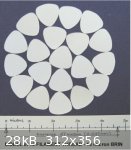
|
|
|
jdowning
Oud Junkie
    
Posts: 3485
Registered: 8-2-2006
Location: Ontario, Canada
Member Is Offline
Mood: No Mood
|
|
With the cocoon filaments combined together to make a thread, the individual threads can now be twisted together to make a string.
According to the author of the 14th C Kantz al-Tuhaf, a silk 'Hadd' string was made from 16 threads. For a 56 cm string length we know that the string
diameter, in either gut or silk, should be about 0.4 mm with the string at maximum tension.
Again, using a scale model as an illustration, the attached image shows a 'Hadd' string cross section made from up from 12 filament threads with Brin
'diameters' of 10 microns. Here it can be seen that the most compact arrangement of the 16 threads gives a string diameter of only 210 microns or
0.210 mm.
To create a uniform cylindrical string the threads must be tightly twisted together - a process that will compact the filaments together further
reducing the string diameter (by an unknown amount at present).
An increasing degree of twist increases the flexibility and elasticity of a string but with a consequential reduction in the string breaking
stress.
In a simply twisted string, the outer threads are stressed more than the inner threads so this is a construction best used for the thinnest of
strings. Once twisted, the elements of a string made using this construction must be locked in position to prevent unravelling. If raw silk is used,
the Sericin may be used to hold everything in place by first softening the gum prior to twisting a string.
A better solution for larger diameter strings is to first bundle the threads equally into 'strands' - in this case either two strands or four strands.
The strands are then first twisted individually in one direction and then combined together with twist in the reverse direction. This is the same
method used for making small ropes or cords and results in a stable, uniform assembly with no tendency to unwind.
The attached images show a scale model of both 2 strand and 4 strand construction prior to twisting.
It is apparent from the scale models that a string made using a typical modern commercial raw silk cocoon filament (with a Brin of 10 microns
'diameter') cannot give the required string diameter of 0.4 mm if the historical data is followed. Scaling up, and using the maximum mean 'diameter'
Brin of modern cocoon silk of around 13 microns results in a 16 thread 'Hadd' string measuring still only about 272 microns or 0.27 mm in diameter
prior to twisting.
In order to make a string of 0.4 mm diameter, the Brin 'diameter' of the thread would need to be about 19 microns.
Clearly, the 14th C string makers had at their disposal threads made from larger 'diameter' cocoon filaments than those from typical commercially
available modern cocoons. Is this possible? The data from the Manchester Exhibition cocoon samples indicates that this very likely was the case.
The question is are Bombyx mori cocoons, yielding this size of filament, available today? A question that, no doubt, is going to be difficult to
resolve given the variability of cocoon size and quality not to mention the effect of environmental conditions resulting - like wine - in some good
cocoon years and some not so good cocoon years. And how does one find cocoons of the best 'vintage' anyway?
This is not going to be easy!
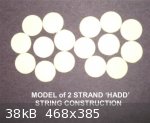
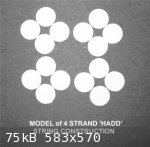
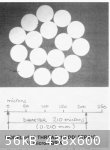
|
|
|
jdowning
Oud Junkie
    
Posts: 3485
Registered: 8-2-2006
Location: Ontario, Canada
Member Is Offline
Mood: No Mood
|
|
Sericin is the natural gum that holds raw silk filament together. It constitutes about 15 to 25% of the total weight of the filament. Raw silk woven
into textiles may be left with the Sericin intact (Raw Silk) but usually the Sericin is removed (de-gummed) in order to give the silk fabric its
distinctive brilliant 'sheen' - triangular section 'Brin' acting like optical prisms to deflect the light. The down side - as far as the textile
industry is concerned - is that removal of the Sericin reduces the weight of the silk and hence the value - silk being sold by weight.
The weight loss may be compensated for by adding metallic salts to the silk - a process known as 'weighting'. The weight increase may be as much as
300 - 400% but silk filament subject to this treatment may be badly weakened and the textiles subject to disintegration even in storage - a major
concern for museum curators.
Sericin may be removed with hot water - or more effectively - with an acidic or alkali solution. The greater the degree of acidity or alkalinity, the
more efficient the removal of Sericin. Hot alkali solutions are used to de-gum silk by the textile industries but the process must be carefully
controlled to avoid damaging the Brin - Fibroin being soluble in strong caustic solutions.
|
|
|
jdowning
Oud Junkie
    
Posts: 3485
Registered: 8-2-2006
Location: Ontario, Canada
Member Is Offline
Mood: No Mood
|
|
The silk string maker has a choice - to use raw silk or de-gummed silk. De- gummed silk is likely easier to twist into a uniform string (less friction
between the filaments), however, removal of the Sericin results in a significant density loss - a negative for a string maker. However, this weight
loss may be recovered by 'weighting' of a string after construction.
Removal of the Sericin may be achieved by soaking the raw silk in a hot acidic or alkaline solution. However, as strong acidic or alkaline solutions
will dissolve the silk Fibroin the solution concentration (acid or alkali), temperature, exposure time etc. is critical.
The attached image is a graph representing % Sericin weight loss of raw silk when treated with hot acidic/alkaline solutions. The pH value is a
logarithmic scale of acidity or alkanility. Pure water has a pH value of about 7. For comparison, lemon juice has a pH value of about 2.2, orange
juice about 3.7, modern acidic rain (!) about 5.6, baking soda solution about 8.2, soap solution about 10, washing soda (sodium carbonate) about 11
and household lye solution (Sodium Hydroxide) about 13.6.
The fibroin is not subject to damage for pH values between about 4 and 8.
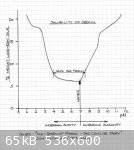
|
|
|
jdowning
Oud Junkie
    
Posts: 3485
Registered: 8-2-2006
Location: Ontario, Canada
Member Is Offline
Mood: No Mood
|
|
Before moving on to a more detailed examination of the historical evidence concerning the manufacture of silk oud strings, a brief history of
sericulture (silk production) in the Middle East and Moorish 'Spain' may be of general interest. This information has been gleaned from various
sources and is here taken at face value without further independent verification on my part.
In the 7th C the Arabs, by conquest, acquired knowledge of sericulture from the Persians spreading this expertise though Africa, Sicily and the
Iberian Peninsula (modern day Spain and Portugal). Establishment of the silk industry throughout the latter territory resulted in Al Andalus being
Europe's main silk-producing region by the 10th C. The Jews, with their involvement in silk trading, weaving and dyeing are credited with introducing
sericulture to Moorish 'Spain'.
At the same time, wool production in 'Spain' was another key agricultural industry so the raw materials for oud string making - silk filament and
sheep's gut - were plentifully available. There is no information about instrument string making but these industries were most likely established
close to the main centres of the textile trades (such as Catalonia) - particularly in Granada to the South.
Following the so called 'reconquest' of Spain by Christian forces, the illusion of economic prosperity - a "bubble" that was fuelled by the
unsustainable influx of Indian silver and gold imported from the Spanish colonies - was soon to "burst". To cut a long story short, actions by the
Spanish crown resulted in virtual destruction of both the prosperous wool and silk industries.
Unfortunately, as Granada was still a centre of Moorish and Jewish population, a series of vindictive acts by the Crown - drastic limits on domestic
consumption and exports of silk and a tremendous tax increase on the industry of Granada after 1561, crippled the industry The 'Inquisition' and mass
deportations - including those skilled in sericulture (Jews and Moors) - guaranteed that the silk industry in Spain would never be the same again - at
least for the next two centuries.
Now for some speculation, on my part, about Spanish instrument strings. It is known that the 16th C Spanish vihuela was fitted with five, six or seven
double courses, tuned like the European lute. The difference is that the vihuela was fitted with unison tuned string courses throughout whereas the
lute, during this period, was fitted with octave tuned string pairs (for the basses).
One explanation offered is that the Spanish (with their Indian gold) could afford to employ unison stringing throughout (the uniform and elastic
basses, assumed to be of gut, imported from 'Germany' - being very expensive).
Another proposal is that the basses (known then as 'Catlines) were made in Spain - presumably so named because they were a specialist product of
Catalonia (Cat-alonia = Cat-lines - get it!). If this is the case then these highly elastic uniform strings could have been made from either gut - or
more likely (?) silk filament.
Interesting that the absolute demise of the Spanish vihuela occurred towards the end of the 16th C - following the destruction of the Spanish silk and
wool industries. No strings - no instrument!
|
|
|
jdowning
Oud Junkie
    
Posts: 3485
Registered: 8-2-2006
Location: Ontario, Canada
Member Is Offline
Mood: No Mood
|
|
Moving on to examine what the early Persian and Arabian sources have to say about silk strings. This information is provided by Dr G.H. Farmer in his
research paper "The Structure of the Arabian and Persian Lute in the Middle Ages". It is not known if Farmer gives all of the information about
strings contained in these sources but this is all that there is to go on for now.
The earliest account is from the court of Khalif Harun (9th C). The minstrel of that court was Ziryab whos oud was a third lighter in weight than
those of the same size generally in use. Ziryab is said to have been the first to use silk strings. His strings "were not spun in hot water as was the
custom".
'As was the custom' seems to contradict the idea that Ziryab was first to use silk strings as it implies that silk strings were already in general
use. Perhaps he was first to use silk strings made using a new technique that did not involve hot water as part of the spinning process? How are we to
interpret and make sense of this meagre information?
Raw silk filament is comprised of two Fibroin strands cemented together with a water soluble gum Sericin. Sericin is a hard, brittle material so if
raw silk filament is to be twisted together to form coherent, uniform threads which, in turn, are then further combined to make strings, the Sericin
must first be softened prior to the spinning (or twisting) operation. This may be done by first softening the Sericin in hot (not boiling) water which
allows the silk filaments to be tightly compressed together - before the Sericin cools and re-hardens - to produce a smooth cylindrical uniform thread
or string. Attempting to twist raw silk filament into threads without softening the Sericin would likely result in a 'lumpy', non uniform, non
homogeneous string - not suitable for musical instruments.
The alternative is to use silk thread that has already been de-gummed prior to twisting into strings. Perhaps this is the material that Ziryab used to
make his strings?
This evidence may support the later 14th C description of silk string making in the Persian "Kanz al-Tuhaf" where the silk threads (? - which Farmer
translates as 'strings') are used to twist into instrument strings. Here the silk threads are first boiled in water and ashes. Wood ash in hot water
forms an alkaline solution that will effectively remove Sericin from raw silk (and destroy the Fibroin if not carefully controlled).
From this it might be concluded that the historical method for making silk oud strings (unlike the earlier Chinese silk strings) is to start with
de-gummed silk. De-gumming allows the silk filaments to be readily twisted tightly together but reduces the linear mass or weight of a string by up to
25%. Furthermore, if a string is of unstable simply twisted rather than stable 'roped' construction, some kind of adhesive must be added to hold
everything together. This glue might also add desirable string mass or weight - mass or weight lost during the de-gumming process.
|
|
|
jdowning
Oud Junkie
    
Posts: 3485
Registered: 8-2-2006
Location: Ontario, Canada
Member Is Offline
Mood: No Mood
|
|
No information is given in the early texts about how much wood ash must be added to the water used to remove Sericin gum from raw silk. Therefore,
some brief trial were made to try to establish the alkaline effect wood ash has when added to water.
Wood ash - the residue remaining after burning wood - is a material of widely varying composition dependent upon species of tree, combustion
conditions etc. The ash is comprised primarily of Calcium Carbonate (lime) 25% to 45% as well as potash (Potassium Carbonate) less than 10% and
Phosphates (phosphoric acid salts) less than 1% plus trace elements. Once used as a raw material for soap and glass making - wood ash was one of the
first agricultural products exported from the pioneering settlements in Eastern Canada where efficient clearance of forested land for agriculture
entailed felling and burning of trees.
At this time of year we heat our home with a wood stove fuelled with white pine logs from our wood lot - so the wood ash used for these trials is
softwood ash. The ash was first passed through a fine sieve to remove charcoal, clinker lumps etc. The ash was then measured by volume and by
weight.
The ash was added in increments to a stainless steel pan containing 500 ml of tap water brought to boiling point after each addition of ash (do not
use aluminium pans as this metal is dissolved by alkaline solutions). The incremental steps each measured (in total) 5, 10, 15, 20 and 30 grams (10
grams of ash is equivalent to about one tablespoonful in volumetric measurement). After each step in adding ash to the water, the solution was allowed
to settle for a few minutes so that the ash residue had settled to the bottom of the pan before measuring pH..
The pH value of the solution was measured at each step using wide range pH test papers ranging from pH 1 to pH 14. The test papers or indicator strips
are paper strips saturated in a chemical that changes colour according to the level of acidity or alkalinity of a solution. The pH level is measured
by comparing the colour of a test strip with a standard colour chart. Wide ranging test papers are not a highly accurate means of measuring pH but are
good enough for these trials. It should be noted that the pH scale is logarithmic so that, for example pH 9 is 10 times more alkaline than pH 8 and pH
10 is 1000 times more alkaline than pH 7 (10X10X10 = 1000)
Test results - the tap water tested at pH 7 (about where it should be). No significant change in pH was detected until the water contained 20 grams (2
tablespoonfuls) of wood ash when the indicator strips showed a pH of about 12. Water containing 30 grams (3 tablespoonfuls) of ash showed a pH of
about 13. Alkaline levels of pH 12/13 can damage silk fibroin if time of immersion of the raw silk is not carefully controlled. These caustic levels
present a safety hazard so plastic gloves and eye protection should be worn when working with these strongly alkaline solutions.
It has been found, by practical experience of others, that a hot (not boiling) solution of around pH 10 will de-gum raw silk in about 30 minutes
without damaging the fibroin. From which it might be concluded that about a tablespoonful of softwood ash (10 grams) added to 500 ml of water, brought
to simmering point, should be about the concentration required to de-gum raw silk in about 30 minutes.

|
|
|
jdowning
Oud Junkie
    
Posts: 3485
Registered: 8-2-2006
Location: Ontario, Canada
Member Is Offline
Mood: No Mood
|
|
The tests with wood ash were repeated today in order to check and verify the results of yesterday's trials. As the digital scales do not have
sufficient resolution to give accurate results by weight, the ash powder was this time measured by volume. Again, the softwood ash powder was added to
500 ml of water, brought to the boil and then allowed to stand for a few minutes until the ash had settled to the bottom of the pan leaving relatively
clear liquid above. The pH of the clear liquid was then measured.
20 ml of ash (this is a bit more than a 'tablespoonful') gave a reading of pH12 using the wide range litmus test papers. 10 ml (a bit less than a
'tablespoonful') gave a reading of about pH 10 although this was difficult to judge exactly when comparing with the colour chart. Narrow range test
papers would give more accurate results.
In view of the variability of wood ash and the relative sensitivity of the solution strength, the best approach might be to test the pH of each batch
of water/ash solution before being used for de-gumming the silk - aiming for a pH of 10.
A higher pH12 is 100 times more alkaline so immersion times of the raw silk would have to be reduced somewhat if this level of alkalinity was to be
employed for de-gumming. No doubt the ash/water solution used by the 14th C silk string makers was a saturated solution so would have had a pH around
12/13 maximum value.
|
|
|
jdowning
Oud Junkie
    
Posts: 3485
Registered: 8-2-2006
Location: Ontario, Canada
Member Is Offline
Mood: No Mood
|
|
After boiling the silk threads in a water/ash solution, the instruction in the 'Kantz al-Tuhaf' is to "wash the threads two or three times in pure
water and then dry them in the shade"
This step is necessary to ensure that all caustic residues from the boiling operation have been completely removed as any residues remaining will
continue to react destructively upon the silk fibroin.
The de-gumming process removes the Sericin gum. Sericin is in three (or four) layers - the outer layer is most easily removed but the inner layers (at
a molecular level), are more difficult to remove. So it is possible that a brief de-gumming might only partially remove the outer Sericin layers. No
matter, removal of the Sericin gum results in a weight loss of from 15% to 25% - which is a negative for the string maker who wants to keep the mass
per unit length of string as high as possible.
The 'Kantz al-Tuhaf instructions go on to say that after twisting the threads into strings "a paste of moderate consistency is then made of gum and a
little essence of Saffron. This is then rubbed on the strings with a piece of linen until it has penetrated into all the parts, when the string is
dried".
What is the 'gum' referred to here? Hard to say for sure but let's assume that it is 'Gum Arabic' - a gum of significant commercial importance over
the centuries.
|
|
|
jdowning
Oud Junkie
    
Posts: 3485
Registered: 8-2-2006
Location: Ontario, Canada
Member Is Offline
Mood: No Mood
|
|
Gum Arabic (or Gum Acacia) is a natural,sugary, edible, vegetable gum harvested from acacia trees in North Africa. Like all true gums it is soluble in
water to make a viscous fluid or jelly-like paste and has wide ranging commercial uses. It is used, for example, as a flexible binder for water colour
pigments and for making hard rubbery 'chewy' type confections like 'jelly beans', 'gumdrops', or 'chewing gum' etc.
The recorded use of Gum Arabic dates back about 5000 years to the times of the Ancient Egyptians. It is the oldest and best known of all the natural
gums.
Gum Arabic has a specific gravity ranging from 1.35 to 1.49 so has a greater density than Sericin gum. Adding this gum as a binder to the de-gummed
silk strings would restore any weight lost and likely be more flexible than the more brittle Sericin. Elasticity is good for instrument strings.
For this string making experiment I shall be using standard grade, unprocessed Gum Arabic that I already have in stock - see the attached image. The
gum is rather attractive with its variable 'amber' like colours. Rather like raw, uncut gemstones!
Gum Arabic in its, more mundane, powdered purified state may be obtained from art supply houses.
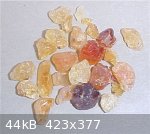
|
|
|
jdowning
Oud Junkie
    
Posts: 3485
Registered: 8-2-2006
Location: Ontario, Canada
Member Is Offline
Mood: No Mood
|
|
The other component of the gum wiped onto the finished silk strings is "a little essence of Saffron". Essence of Saffron is taken to mean the
'essential oil' of the Saffron flower (Safranal) obtained by distillation of the stigmas of the Saffron Crocus flower. This is a highly concentrated
volatile oil.
A dilute solution of the oil may also be prepared by simply boiling the Saffron stigmas in water.
The herb Saffron is the stigma of the Saffron Crocus flower. There are three stigmas per flower so it takes from 50,000 to 75,000 flowers to make a
pound (0.45 Kg) of Saffron - all picked by hand! Current retail value of Saffron is about $300 US an ounce (28 grams) the most costly herb available
on the market today (as it was in ancient times).
Cultivated in ancient Persia it was introduced to Spain by the Moors in the 8th C where it is still an important agricultural export. The name comes
via Persian/Farsi (za feran) to Arabic (za faran) derived from the adjective (asfar) meaning 'yellow' (source Wikipedia).
Saffron is used today primarily in cooking due to its distinctive aroma and as a food dye - imparting a golden yellow colour to food. It also has
medicinal applications.
The attached images show a variety of the beautiful Saffron Crocus with its three red coloured stigma (source Wikipedia) and the dried Saffron herb
sample that I will be using for the string making experiments. The image of the dried herb measures about 3 cm across and represents about a gram in
weight (a teaspoonful) costing $10! Also, I doubt if this example is top grade material.
Why do the instructions in the Kanz al-Tuhaf require addition of the concentrate 'essence of Saffron" to the Gum Arabic? The text does not say but
later, when discussing the preparation of gut strings for the oud, goes on to describe the finishing process where "The (gut) strings are stained with
Saffron or whitewash this being rubbed into the strings until they are dry"
So, it would seem, that the Saffron here is being used as a dye - to colour the Gum Arabic and, hence the silk strings a golden yellow?
Nevertheless, perhaps there is another purpose based simply upon the intrinsic value of the herb or , more deeply, some of its other ancient
traditional applications?
Or maybe oil of Saffron has some preservative properties when added to the gum to ensure a longer string life?
For this string making experiment, Saffron will be added to hot water to dye the solution yellow. This water will then be used to make a paste of the
Gum Arabic - to be rubbed into the finished silk strings.
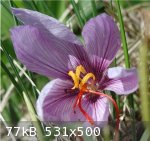
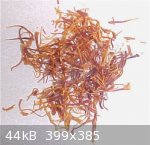
|
|
|
jdowning
Oud Junkie
    
Posts: 3485
Registered: 8-2-2006
Location: Ontario, Canada
Member Is Offline
Mood: No Mood
|
|
Note that the previous posting has been edited to give the current retail price of Saffron at about $300 an ounce (28 grams) or about $5000 US a pound
(450 grams). One good reason not to attempt production of essential oils from Saffron by distillation - because of the large quantity of plant
material required.
For interest, the following preparation of Gum Arabic as a flexible binder for painting designs on buckskin clothing is to mix 300 grams of powdered
Gum Arabic with 1 litre of boiling water (i.e 1 part gum to 2 parts water) to form a smooth paste of a creamy consistency. The paste must not be
watery to avoid absorption by the buckskin causing colour bleeding. The paint pigments are mixed with the prepared binder.
The recipe goes on to mention the addition of 3 drops of clove oil (essence of clove) to retard spoilage of the paste.
|
|
|
jdowning
Oud Junkie
    
Posts: 3485
Registered: 8-2-2006
Location: Ontario, Canada
Member Is Offline
Mood: No Mood
|
|
The 14thC Kanz al-Tuhaf gives the most detailed but brief account of silk string construction for a five course oud.
The string maker of that period in time seems to have started by de-gumming commercially available threads made up from raw cocoon silk filament -
threads that likely would have normally been destined for weaving into fabric.
The number of threads twisted into each size of string is given as follows:
HADD 16 threads
ZIR 24 threads
MATHNA 32 threads
MATHLATH 48 threads
BAMM 64 threads
It is not known how many cocoon filaments were in each thread used by the string makers - commercial raw silk threads might be reeled from any number
of cocoons (as it is today) dependant upon the thickness of thread required.
The number of filaments per thread was important to the early Chinese string maker.Their early texts state that the threads used to make strings for
the qin (Zither) should contain an optimum 12 cocoon filaments - although the size ('diameter') of the filaments used by the Chinese is not known. The
'diameter' of the raw silk cocoon filaments could well have been much greater than typical cocoon filament available today.
The previously posted idealised model of a HADD string made from 16 threads demonstrates that a thread made from only 12 de-gummed typical modern
cocoon filaments cannot give the required string diameter of 0.4 mm.
The attached calculation sheet derives the relative diameters of the Kanz al-Tuhaf strings based upon an assumed diameter of 0.4 mm for the HADD
string. Using the idealised model, the de-gummed thread diameter works out at around 0.10 mm (100 microns) which is about twice the diameter of a
thread made from 12 modern cocoon filaments.
There are, therefore, two possible alternatives available to the modern silk string maker :
1) Starting with Bombyx mori cocoons, reel the silk filament from the required number of cocoons and use only the first 200 to 300 metres of filament
for making the strings - this part being the largest diameter within a cocoon. The aim is to use the minimum number of filaments to make a de-gummed
thread measuring 100 microns in diameter. This number would have to be established by trial and error.
2) Use commercially available raw silk thread - measuring 100 microns in diameter after de-gumming - as a starting point. This thread might contain
considerably more smaller 'diameter' filaments than 12, and is a number that might vary from year to year dependent upon cocoon quality and yield for
a particular year.
The string making experiments will be undertaken using both alternatives. The cocoons have been shipped already but some basic reeling apparatus will
have to be made first - as well as apparatus for twisting the threads into strings.
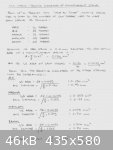
|
|
|
jdowning
Oud Junkie
    
Posts: 3485
Registered: 8-2-2006
Location: Ontario, Canada
Member Is Offline
Mood: No Mood
|
|
The silk required for the string making trials has arrived!
I ordered 100 Bombyx mori cocoons from Treenway Silks. BC, Canada at
http://www.treenwaysilks.com
Enquiring about supply of raw silk filament, the company did not have in stock the reeled filament size that I was interested in so contacted their
supplier in China to see what was commercially available. As a result - and because I was (and still am) not exactly sure how silk measured in denier
will convert to microns diameter after de-gumming - their supplier kindly sent a very generous free sample of their raw silk to try. The label on the
hank of silk reads 40/44 that I assume means 40/44 denier but this will have to be confirmed. Certainly enough silk to carry out meaningful
comparative trials. Thank you Treenway Silks for your interest and help in making this a promising start to the investigation.
In order to handle the silk, the hank will first have to be reeled on to a bobbin otherwise it will just become a tangled mess. So the next job is to
make a winding apparatus to do this work.
The raw silk appears - to my inexpert eye - to match the Kantz al-Tuhaf description that " the threads should be white, smooth, of equal gauge and
well finished"
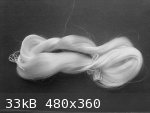
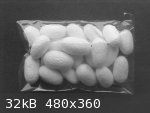
|
|
|
jdowning
Oud Junkie
    
Posts: 3485
Registered: 8-2-2006
Location: Ontario, Canada
Member Is Offline
Mood: No Mood
|
|
Silk thread is measured in Denier - equal to a length of 9000 metres weighing 1 gram (or 450 metres weighing 0.05 gram).
Converting silk thread in Denier measurement to diameter is complicated due to the variation in the density and 'diameter' of the silk filaments that
are combined together to make a thread. For this reason silk thread measured in Denier reflects this variation with a maximum and minimum value, for
example a 10-12 Denier thread has an average Denier count of 11. The finest practical thread is about Denier 6 - 8.
The attached graph of thread diameter versus Denier has been drawn from data published in "Raw Silk Properties, Classification of Raw Silk and Silk
Throwing" by Warren P. Seem, 1922. (this book is available as free download from the Internet Archive website).
From this graph it can be seen that the silk sample from 'Treenway Silks' - measuring 40/44 Denier (average Denier count of 42) - has a mean diameter
of about 97 microns or 0.097mm (i.e. a little less than the calculated required thread diameter of 0.10 mm for this project but close enough).
We are dealing with very small dimensions 97 microns being the equivalent of 0.0038 inch or less than 4 thou.
I now realise that there should be little difference between the diameter of a raw silk thread and a thread that has been de-gummed as the multiple
seracin coated filaments of a raw silk thread are drawn tightly together during the reeling process and the sericin gum - being in a softened state -
is just compressed to fill the gaps between the fibroin fibres (see the idealised models previously posted.
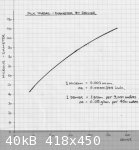
|
|
|
jdowning
Oud Junkie
    
Posts: 3485
Registered: 8-2-2006
Location: Ontario, Canada
Member Is Offline
Mood: No Mood
|
|
Just to further clarify the question of Denier versus thread diameter illustrated by taking the sample skein (or hank) of silk that will be used for
this project as an example.
The skein is graded as 40/44 Denier and weighs about 22 grams (measured on a digital kitchen scale - resolution 1 gram).
The silk, therefore, varies somewhere between 40 grams and 44 grams per 9000 metres along the total length of the thread.
Diameter (from the conversion table), therefore, can vary between 93 microns and 98 microns along the total length of the thread.
The length of thread in the sample skein will, therefore measure somewhere between 22/40 X 9000 and 22/44 X 9000 or between 4500 metres and 4950
metres. More than enough for these experiments.
However, in order to use the silk thread, it must first be wound from the skein on to a bobbin or reel. In order to do this, a winding machine must be
constructed. I shall be using a design published in "Silk, its production and manufacture" by Luther Hooper (the book is available as a free download
from the Internet Archive website). These old texts are often useful in providing information about hand production methods and equipment.
The attached image illustrates the machine - made mostly from wood.
The skein is first mounted on a freely rotating 'swift' (A), the diameter of the 'swift' being adjustable by moving thread cross-ties on the thin
'spring loaded' spokes (2 and 3).
The bobbin (G) rotates in a groove in the frame of the machine. Its steel spindle has a small lead sleeve at one end (E) that rests, under its own
weight, on a leather covered drive wheel. This provides a low friction drive for the bobbin essential to avoid breakage of the fine silk thread during
winding. If the thread should tangle on the 'swift' the bobbin will slip on the drive wheel preventing the thread breaking.
In order for the thread to be wound evenly on the bobbin it passes through a wire loop (F) that moves from side to side with an oscillating motion
driven by a crank connected to the main drive of the machine.
A fairly straightforward task to build but this work will have to wait until the abnormal sub zero weather conditions for this time of year improve as
they should do next week (hopefully). The outside temperature this morning is minus 24 Celsius with the workshop at minus 8 C.

|
|
|
jdowning
Oud Junkie
    
Posts: 3485
Registered: 8-2-2006
Location: Ontario, Canada
Member Is Offline
Mood: No Mood
|
|
A bit more information has come to light about oil of saffron (so far assumed to be the 'essence of saffron' translated by Dr G.H. Farmer).
Oil of saffron (or saffron oil) comes in two possible variants.
The first is produced by distilling a mixture of the saffron herb in water. However, according to some authorities, scarcely any volatile oil is
obtained by this method. A modern method to improve yield is the CO2 extraction process but this is a process that was definitely not available to the
ancients!
The second method is that employed by chefs for use in preparing food where the dry saffron herb is crushed and then mixed with water or oil (e.g.
olive oil) to produce a convenient liquid flavouring or colouring additive for food dishes.
If the saffron is to be used as a dye, a 'tincture of saffron' can be easily made by mixing the crushed herb with methyl alcohol (wood alcohol - a
material well known to the ancients). This produces an orange dye concentrate that is soluble in water.
Saffron oil - made by the CO2 extraction process - is available on the market at a reasonable price but is clearly not the substance mentioned in
the14th C Kanz al-Tuhaf.
Saffron has been used for thousands of years as a herbal medicine - as it still is today - a curative for a huge range of ailments from mental
disorders to diabetes!! It is even said that Cleopatra bathed in saffron as an aphrodisiac - so caution to oud players using silk strings dyed with
saffron!! (could this be a market niche of some kind!)
On the basis of this information I shall experiment with 'tincture of saffron' as a dye for the silk strings but suspect that 'essence of saffron'
also had some kind of medicinal anti-bacterial property perhaps preventing (or delaying) deterioration of the gum arabic glue used to bind the silk
threads together?
|
|
|
Sazi
Oud Junkie
    
Posts: 786
Registered: 9-17-2007
Location: Behind my oud
Member Is Offline
Mood: مبتهج ; ))
|
|
Quote: Originally posted by jdowning  |
... suspect that 'essence of saffron' also had some kind of medicinal anti-bacterial property perhaps preventing (or delaying) deterioration of the
gum arabic glue used to bind the silk threads together? |
Perhaps Benzoin would be an authentic option there?
|
|
|
| Pages:
1
2
3
..
13 |